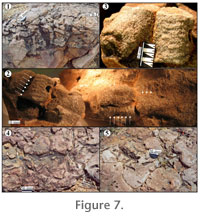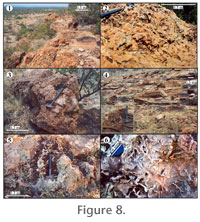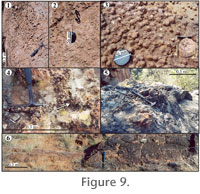| |
ASSOCIATED PROBABLE TRACE FOSSILS
 In close stratigraphic association with these enigmatic structures, each study locality contains a number of probable trace fossils of various shapes, sizes, and vertical and lateral distributions (Figure 7,
Figure 8,
Figure 9). Although present elsewhere in the Clarens Formation, no vertebrate tracks or body fossils of other organisms were found in close proximity (< 1 km radius) to the regularly-oriented horizontal structures at any of the study localities. In close stratigraphic association with these enigmatic structures, each study locality contains a number of probable trace fossils of various shapes, sizes, and vertical and lateral distributions (Figure 7,
Figure 8,
Figure 9). Although present elsewhere in the Clarens Formation, no vertebrate tracks or body fossils of other organisms were found in close proximity (< 1 km radius) to the regularly-oriented horizontal structures at any of the study localities.
The most conspicuous biogenic structures among the associated features are some straight to gently curved, irregularly branching, internally distinctly laminated, randomly oriented tubes with uniform ~10 mm diameter and distinct ornamentation in the form of a ribbed outer surface (Figure 7.1, 7.2). The tubes, which lack chamber-like terminations, are filled by alternating laminae of 0.1 and 0.25 mm diameter sand grains (Figure 7.2, 7.3). The coarser laminae are 1.1 mm, while the finer ones are 0.1 mm thick. The consecutive laminae seem to end abruptly against the massive host rock, and in thin-sections, no constructed walls or linings are visible.
 Another cylindrical feature, identical in size to the internally laminated, randomly oriented tubes, are straight to gently angled, locally irregularly branched, randomly oriented, 40-50 mm long open (unfilled) tubes that are ~10 mm in diameter (Figure 7.1, 7.4, 7.5). In addition to these, thinner, 3 to 5 mm tubes, with massive fill, but otherwise similar morphological characters, are also common as positive, negative and full relief structures (Figure 8.1-8.6). Unlike the enigmatic structures, these features are relatively abundant, form well-developed network of tubes and give the host sandstones a sponge-like (bioturbated) texture. Locally, these complex mazes of tubes form ~0.5 to 0.8 m thick layers, and where the outcrop continuity permits, they can be traced laterally for several tens of meters in (Figure 8.1, B). Another cylindrical feature, identical in size to the internally laminated, randomly oriented tubes, are straight to gently angled, locally irregularly branched, randomly oriented, 40-50 mm long open (unfilled) tubes that are ~10 mm in diameter (Figure 7.1, 7.4, 7.5). In addition to these, thinner, 3 to 5 mm tubes, with massive fill, but otherwise similar morphological characters, are also common as positive, negative and full relief structures (Figure 8.1-8.6). Unlike the enigmatic structures, these features are relatively abundant, form well-developed network of tubes and give the host sandstones a sponge-like (bioturbated) texture. Locally, these complex mazes of tubes form ~0.5 to 0.8 m thick layers, and where the outcrop continuity permits, they can be traced laterally for several tens of meters in (Figure 8.1, B). In addition to the stratified form, the tube network also occurs in various sizes and more or less distinct forms (e.g., blobs, domes, pears) (Figure 8.3-8.6). These tube networks are surrounded by either massive (Figure 8.4, 8.5) or well-stratified host rock (Figure 8.6) (see
Bordy et al. 2004 for further details). In addition to the stratified form, the tube network also occurs in various sizes and more or less distinct forms (e.g., blobs, domes, pears) (Figure 8.3-8.6). These tube networks are surrounded by either massive (Figure 8.4, 8.5) or well-stratified host rock (Figure 8.6) (see
Bordy et al. 2004 for further details).
In the ichnological literature, tube-like structures of similar size, random distribution pattern and surficial morphology are commonly interpreted as organism-produced burrows and are attributed to a range of organisms from earthworms to arthropods (Bromley and Asgaard 1972;
Ekdale et al. 1984;
Hasiotis 2002).
|